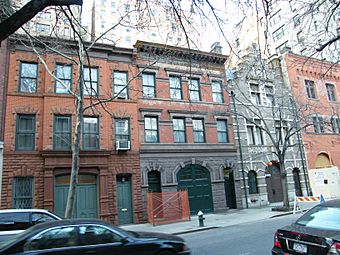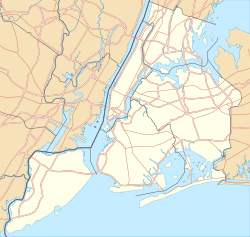East 73rd Street Historic District facts for kids
|
East 73rd Street Historic District
|
|

168–174 East 73rd Street, all former
carriage houses on south side, 2009 |
|
| Location | Upper East Side, New York, NY |
|---|---|
| Area | 1.4 acres (5,700 m2) |
| Built | 1860–1920 |
| Architect | Various |
| Architectural style | Italianate, Romanesque, Beaux-Arts |
| NRHP reference No. | 82003374 |
Quick facts for kids Significant dates |
|
| Added to NRHP | July 22, 1982 |
The East 73rd Street Historic District is a special block in New York City. It's located on the Upper East Side of Manhattan, between Lexington and Third Avenues. This area is famous for its unique small rowhouses. These buildings were mostly built between the mid-1800s and early 1900s.
Many of these houses were originally "carriage houses." These were like garages for horses and buggies belonging to rich families on the Upper East Side. Famous people like Edward Harkness and Joseph Pulitzer owned buildings here. Some famous architects, like Richard Morris Hunt, designed them. Over time, many were changed to hold cars instead of horses. Today, some are still homes.
This block looks very different from the areas around it. While other blocks got taller, modern buildings, East 73rd Street kept its original charm. In 1980, the city made these buildings New York City Landmarks. Two years later, the whole block became a "historic district" on the National Register of Historic Places. This means it's officially protected for its history and architecture.
Contents
Exploring the East 73rd Street Historic District
This section tells you more about where the district is and what makes it special.
Where is the East 73rd Street Historic District?
The district covers most of the buildings on both sides of 73rd Street. It stretches between Lexington and Third Avenues. There are fifteen buildings in total that are part of this historic area. These include numbers 161 to 169 and 166 to 182 East 73rd Street.
The district does not include the two large apartment buildings at Lexington Avenue. This area is mostly flat. The buildings here are usually three to five stories tall. This is much lower than the modern buildings on nearby blocks. All the buildings in the district are considered important to its history.
A Look Back in Time: History of the District
Building started on the Upper East Side in the early 1860s. Rowhouses were built for middle-class families. Two of these original rowhouses, at 171 and 175 East 73rd, are still standing today.
Later in the 1800s, wealthy New Yorkers built large homes near Central Park. They needed places for their horses and buggies. East 73rd Street was a good spot for these "carriage houses." It was close enough for a short walk but far enough to avoid noise and smells. These buildings often had rooms for the servants who cared for the horses.
The first carriage house, at 166 East 73rd, was designed in 1883. It was for an art collector named Henry Marquand. In 1890, a large stable at 182 was built. Owners could rent space there if they didn't want their own carriage house. More carriage houses were built in the 1890s and early 1900s.
Around 1900, cars started to become popular. In 1906, the building at 177–79 East 73rd was built just for cars. Two years later, the stable at 182 was also changed to hold cars.
In 1907, Edward Harkness, a wealthy philanthropist, bought 161 East 73rd. He turned it into a garage with a squash court and rooms for his driver. Other carriage houses also became garages or homes with garages. By 1920, the block looked much like it does today.
Some buildings on the street also became important for music. The MacDowell Club, named after a famous composer, owned 166 East 73rd for a while. Later, the Dalcroze School of Music, a special music training school, was located at 161 East 73rd for several decades.
Types of Buildings You'll See
The buildings in the district fit into three main types. They show how the area changed over time.
Old Rowhouses
The two oldest buildings are rowhouses at 171 and 175 East 73rd Street. They are on the south side of the street. These narrow, three-story brick buildings were built in 1860. They have stone around the windows and doors. They also have decorative wooden roofs. The house at 171 still has an old-fashioned cast iron porch. These porches used to be common but are rare now.
Carriage Houses
Most of the buildings are carriage houses. They all follow a similar basic design. The ground floor usually has a large arched entrance. This was for the horses and carriages. There's also a smaller door for people. Inside, many have been changed to be modern homes. They are usually two or three stories tall.
Some carriage houses stand out. Numbers 161 and 163 have rough brick with smooth stone trim. You can see horse-related designs carved into the ground floors. The building at 165 East 73rd is in the Beaux-Arts style. It has yellow brick and carved plant designs. The Romanesque-style house at 166 has a detailed brick roofline. It shows the year it was built, 1883, in metal letters.
Other carriage houses show different styles. At 168 East 73rd, the roof has a unique stepped shape. This is a rare style in New York City. Next door, 170 and 172–74 show the Neo-Grec style. The last carriage house on the south side, 178 East 73rd, mixes Beaux Arts decorations with Georgian brickwork.
Commercial Buildings
The two tallest buildings are at 177–79 and 182 East 73rd. They are five stories high. These were built for people who wanted to rent space for their vehicles. The building at 177–79 was the only one designed specifically for cars. It's a Beaux-Arts style building with a stone and granite base. The middle floors are brick with terra cotta trim. Its top floor has a special mansard roof with three large dormer windows. These windows have fancy terra cotta frames. One window looks like a triumphal arch.
Across the street, 182 East 73rd is a brick Romanesque Revival building. It has stone trim and decorative ledges. Above the fourth floor, you can see "S KAYTON & CO." carved into a panel. Many of its windows are set within arches.
See also
 In Spanish: Distrito histórico de la Calle 73 para niños
In Spanish: Distrito histórico de la Calle 73 para niños


